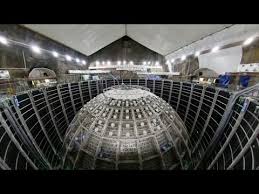China’s Jiangmen Underground Neutrino Observatory:

After years of construction, China’s Jiangmen Underground Neutrino Observatory (JUNO) is set to begin data collection on neutrinos. This cutting-edge particle physics experiment aims to greatly enhance our understanding of the subatomic particles.
- JUNO will observe solar neutrinos for a real-time view of solar processes and study neutrinos from uranium and thorium decay within Earth to gain insights into mantle convection and tectonic plate movement.
- Set to become operational in late 2025, JUNO will start ahead of the US Deep Underground Neutrino Experiment (DUNE), scheduled around 2030.
- International Collaboration: JUNO’s research team includes scientists from the US, France, Germany, Italy, Russia, and Taiwan, demonstrating extensive international cooperation.
- Future Applications of Neutrino Research: While direct applications for neutrinos remain distant, researchers speculate about potential communication uses, such as transmitting long-distance messages through solid matter at near-light speed.
- Neutrinos are subatomic particles that have no electric charge, have a small mass, and are left-handed (the direction of its spin is opposite to the direction of its motion).
- They are the most abundant massive particles in the universe. They are produced whenever atomic nuclei combine (as in the sun) or split apart (as in a fission reactor or particle accelerator).
- The only ways neutrinos interact is through gravity and the weak nuclear force.
- They can change from one type (electron-neutrino, muon-neutrino, tau-neutrino) to another as they travel and interact with other particles, a phenomenon sometimes called neutrino oscillation.
- Neutrinos can carry information across large distances due to their low interaction rate with matter.
- They could potentially be used to transmit information, replacing electromagnetic waves in communication channels.




